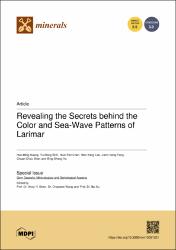Mostrar el registro sencillo del ítem
Revealing the secrets behind the color and sea-wave patterns of larimar
| Licencia | This article is an open access article distributed under the terms and conditions of the Creative Commons Attribution (CC BY) license. | es |
| Autor | Huang, Hao-Ming | |
| Autor | Shih, Yu-Hong | |
| Autor | Chen, Huei-Fen | |
| Autor | Lee, Hao-Yang | |
| Autor | Fang, Jiann-Neng | |
| Autor | Shen, Chuan-Chou | |
| Autor | Yu, Bing-Sheng | |
| Fecha de admisión | 2023-10-10T23:41:01Z | |
| Fecha disponible | 2023-10-10T23:41:01Z | |
| Año | 2023 | |
| Citación | Huang, H. M., Shih, Y. H., Chen, H. F., Lee, H. Y., Fang, J. N., Shen, C. C., & Yu, B. S. (2023). Revealing the secrets behind the color and sea-wave patterns of larimar. Minerals, 13(9), 1221. Recuperado de: | es |
| URI | https://bvearmb.do/handle/123456789/3441 | |
| Sinopsis | In the last century, a blue–green colored gemstone known as Larimar with a special sea-wave pattern was discovered in the Dominican Republic. Larimar is composed of the mineral pectolite, which has a chemical composition of NaCa2Si3O8(OH) and is usually white in color. Cu2+ has always been considered to be the primary genesis of the blue color shown in Larimar, because native copper often grows together with Larimar. To clarify whether copper is the main reason for the origin of blue–green pectolite, we utilized laser ablation inductively coupled plasma mass spectrometry (LA-ICP-MS) techniques to analyze trace elements in the pectolite samples and compared the relationship between elements and colors. The results show that vanadium and iron are the main origins of the sky-blue and green color of Larimar. We also discovered that it is not only the chemical elements that affect the color shades of the mineral, but the orientation of the radial fiber crystals also plays a critical role. The sea-wave pattern and the changes in the color saturation of radial pectolite are due to the transmittance of visible light through different viewed angles under changing crystal orientations. Our results reveal the chemical and physical factors behind the color and sea-wave pattern of Larimar. In addition, to our knowledge, this is the first time that the formation age of Larimar has been proven to be approximately equal to or younger than 40 ka, using the U-Th dating of calcite growth together with pectolite. | es |
| Idioma | English | es |
| Publicado | Minerals, 13(9), 1221 | es |
| Derechos | © 2023 by the authors. Licensee MDPI, Basel, Switzerland. | es |
| URI de derechos | https://creativecommons.org/licenses/by/4.0/ | es |
| Materia | Recursos naturales - República Dominicana | es |
| Materia | Geología ─ República Dominicana | es |
| Materia | Mineralogía ─ República Dominicana | es |
| Título | Revealing the secrets behind the color and sea-wave patterns of larimar | es |
| dc.identifier.doi | https://doi.org/10.3390/min13091221 | |
| Tipo de material | Article | es |
| Tipo de contenido | Scientific research | es |
| Acceso | Open | es |
| Audiencia | Technicians, professionals and scientists | es |
Ficheros en el ítem
Este ítem aparece en la(s) siguiente(s) colección(es)
-
Investigación ambiental [1698]


